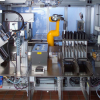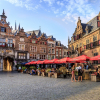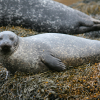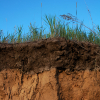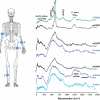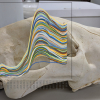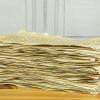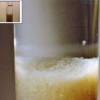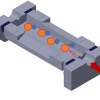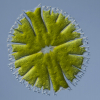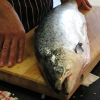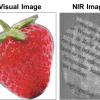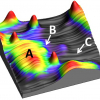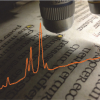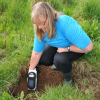Articles
In quantitative analysis, is it better to weigh materials when making up standard solutions or to use volumetric techniques? Traditionally, the answer has been “volume”, however, things may not be as straightforward as they seem. Henk-Jan and colleagues have conducted a new experiment, using robots for both sample preparation and spectroscopic analysis which may provide a definitive answer. Unfortunately, the answer must wait for publication of their paper, but Tony and Henk-Jan’s history of this question makes interesting reading nevertheless.
FT-IR spectroscopy and ED-XRF are used to determine the origin of contaminants in food that may, or may not, have originated from dental materials.
With a significant proportion of our regular readership probably under home lock-down, we were wondering if we could help you at this difficult time by pointing out some useful online resources. So, when we finally come out of this pandemic, you could do so better skilled and more up-to-date than when we went in to it.
Tony and Lutgarde Buydens give us an update on the planning for the major EuroAnalysis 2021 conference, which is being held in Nijmegen, the Netherlands, at the end of August 2021. At this stage, they are keen to gather suggestions from readers on topics they would like to see covered. Groups are also invited to consider hosting their own event under the EuroAnalysis 2021 banner.
The authors offer many useful points to consider when using pre-processing techniques.
This article reports on work using NIR spectroscopy to investigate the physiology of seals during diving. As well as the versatility of NIR spectroscopy, the technical achievements involved in placing a spectrometer on a seal without harming it and recording data underwater are amazing.
This column shows how well the Theory of Sampling is able to address the powder sampling difficulties that have plagued the pharmaceutical industry for a long time. Definitely, a practical example of the importance of representative sampling.
The authors describe work they are doing to develop a green methodology to determine soil organic matter. If the World’s population is to be fed in the future, improvements to agricultural productivity are required and soil fertility will be key to this. Current methodologies are time-consuming and expensive, but visible-near infrared spectroscopy has the potential to replace them.
Burned bones are often found in archaeological sites as a result of fire or funerary practices and are often the only preserved human remains. Using inelastic neutron scattering, infrared and micro-Raman spectroscopies, the authors can reach definitive conclusions as to the temperature at which the bone was burned. This enables archaeologists and anthropologists to learn more about how ancient civilisations used fire for funerary, burial or cooking purposes.
Knowledge of the origin of bones has applications in anthropology, archaeology and forensics; NIR spectroscopy, even with handheld instruments, is showing promise in being able to differentiate bones from different species.
Spectroscopy is widely used in forensics, but the determination of the age of documents was one application I had not considered. With a huge variety of papers and inks available, each with their own ageing profiles, and with such ageing depending on environmental factors, the determination of the age of a document is not straightforward. However, infrared spectroscopy and chemometrics may have the answer.
Jacques Thierie’s article raises a seemingly impossible observation: that in some cases, transparency can exceed 100 %.
Nick Polfer gives an excellent introduction to the recent technique of infrared ion spectroscopy. Ions held in the ion trap of a mass spectrometer can be probed with a tuneable light source, and its photodissociation studied as a function of the photon frequency. Nick believes that the technique will make an impact in small molecule analysis, such as metabolites, drugs and classes of molecules containing many isomers.
Tony Davies continues his quest to find out what you all need to work more efficiently. You will remember that in the last issue, Tony introduced his survey to discover what developments were needed in spectroscopy by readers. Some of the initial responses are explored, and Tony finds that he has opened a “can of worms”.
Different spectroscopic techniques have been combined to provide additional and complementary information for decades. Increasingly, this is being expanded beyond just two techniques and may include spatial/imaging information as well. All of which bring their own challenges. In “Multimodal imaging of cells and tissues: all photons are welcome”, David Perez-Guaita, Kamila Kochana Anja Rüther, Phillip Heraud, Guillermo Quintas and Bayden Wood report an example of these new approaches. They look at the use of infrared, Raman and X-ray fluorescence spectroscopies to obtain combined imaging data of whole algal cells and discuss how to overcome the challenges.
Colette Germon, Tony Davies and Paul Jones look at “Combining teaching chemometrics, with attenuated total reflection–infrared spectroscopy and food authentication”. They describe a teaching project based around the detection of food fraud. It is a good example of teaching spectroscopic data handling and advanced analysis techniques. They have investigated how adulteration and misrepresentation of meat and fish can be detected, as well as whether frozen and then thawed fish could be differentiated from chilled fish.
We all know how spectroscopy and other analytical technologies have played important roles in detecting fraud and in authentication. Paper collages, or photomontages, are part of the art market that is seeing much interest amongst collectors. It is difficult to detect forgeries just through expertise. The use of NIR imaging offers a number of ways to identify forgeries or authenticate the collage non-destructively; from determining the glue used to the revealing of printing on the back of the pieces or paper, which often have been taken from books and magazines.
This article demonstrates the capability of the near-field method to probe polymer microspheres within a protein matrix, and we present the first IRSR photothermal near-field Fourier transform infrared (FT-IR) spectrum from within an individual biological cell, which establishes the feasibility of hyperspectral mapping at sub-micrometre resolution in a practical timescale.
It is not every issue that one of our articles starts with a quotation in medieval English, and it is appropriate as two of our articles cover the use of spectroscopy in cultural heritage. This is yet another field where the rich information provided by spectroscopy, along with its non-destructive nature (for many techniques), portability and ability to generate chemical images make it the answer to many questions. Kate Nicholson, Andrew Beeby and Richard Gameson are responsible for the medieval English at the start of their article “Shedding light on medieval manuscripts”. They describe the general use of Raman spectroscopy for the analysis of historical artefacts, and, in particular, their work on medieval European manuscripts and 18th century watercolour pigments. They stess the importance of checking the actual laser power density to avoid damage to priceless artefacts.
Once again developments in portable instruments lead to greater ease of use and the ability to measure far more samples. They describe the application of FT-IR, NIR and XRF spectroscopies to the development of the National Soils Inventory of Scotland, and their work in developing the use of handheld instruments, particularly FT-IR spectrometers.

